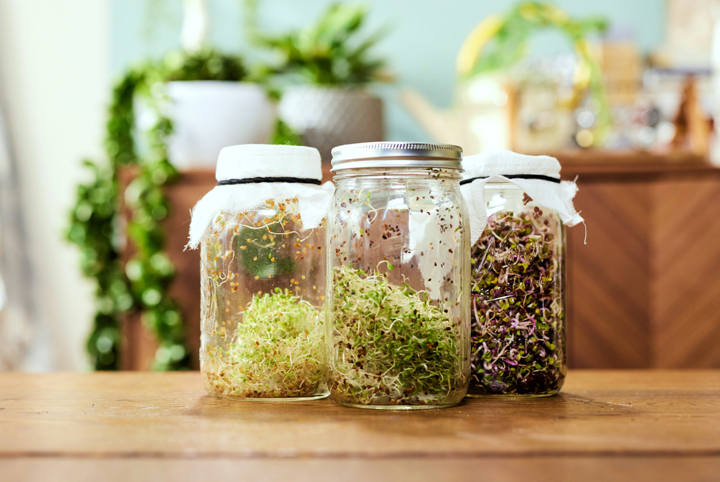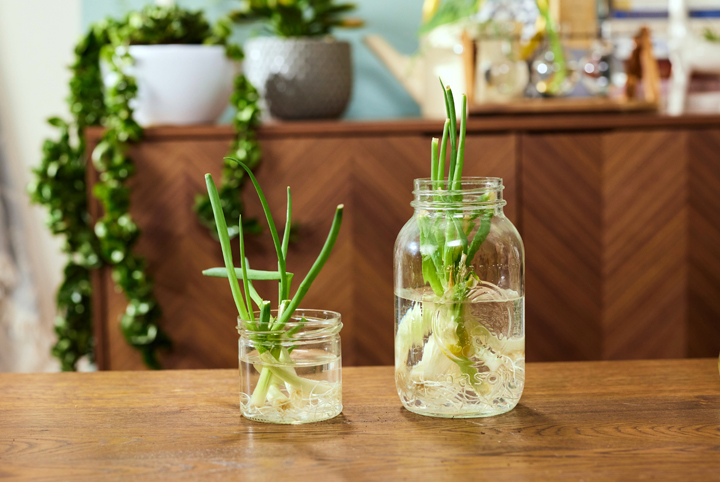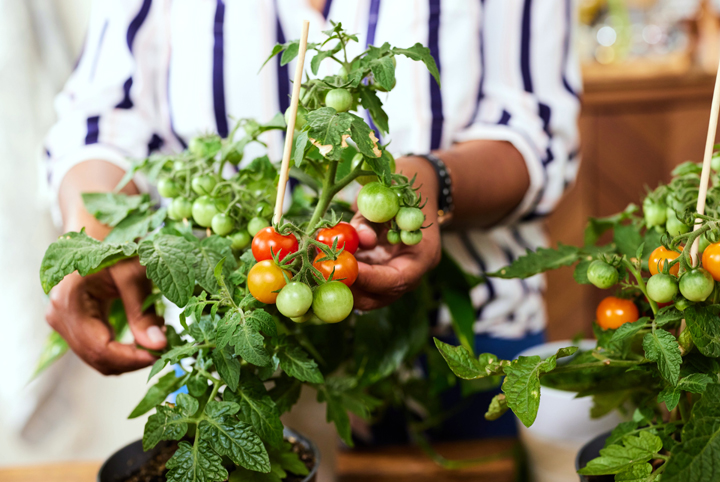
Gardening doesn’t just have to be a summer pursuit. I love the indoors, and I love being able to grow fresh herbs and veggies to add to meals right in my own kitchen. Whether you’re a seasoned outdoor gardener or brand new to gardening in general, these 5 veggies are an easy and delicious way to start growing your own food indoors!
Microgreens
Microgreens are tender, delicious, nutrient-dense vegetable greens that can add texture and variety to soups, salads, smoothies, sandwiches, and more. There are many different varieties of microgreens, so it’s always a good idea to follow the instructions on the seed packet you receive.
To get started growing microgreens, fill a tray with a shallow layer of moist soil but ensure that the soil isn’t soggy. Seed the tray thoroughly, making sure to get the corners. Don’t worry about covering the seeds with soil, they can hang out on top of the soil. Now cover the tray until you see signs of germination. Once you see some sprouting action – usually in a day or two – place the microgreens in a sunny windowsill or underneath a growlight.
Once your seedlings are 8 to 10 centimeters tall (3 or 4 inches), you can harvest them with some sharp scissors and use them in all your culinary pursuits!
Related: How to Create Your Own Vertical Garden

Sprouts
Sprouts are easily my favourite indoor veggie to grow. From salads to sandwiches, sprouts add a bright, fresh flavour and a bit of texture to virtually any meal! Sprouts are neat because they actually don’t need soil to grow. In fact, aside from the sprout seeds themselves, they don’t need any kind of special equipment to grow! Although you can grow your sprouts in a special terracotta sprouting tower, I like to grow mine in a standard mason jar. I secure a piece of clean cheesecloth to the top of the jar with an elastic band.
From there, I follow the directions on the back of the seed package. Generally speaking, the instructions will specify how long to soak the seeds to activate them. It’s important to rinse the sprouts two or three times a day, and leave the jar turned upside-down in a bowl to drain. If all goes well, your sprouts will be ready to eat in four or five days!
It’s a good idea to regularly inspect your sprouting jar. In addition to it just being fun to watch your sprouts grow, the moisture associated with the sprouting process can sometimes lead to mold. If you notice white fuzzy cobweb-looking growth among your sprouts, unfortunately it’s time to toss your sprouts and thoroughly clean and disinfect your jar.
Related: Signs You’re Overwatering Your Plants (and 5 Signs You Aren’t Watering Them Enough!)

Green Onions
I put green onions on everything: burrito bowls, pasta dishes, salads, grain bowls, everything. It If you love these delicious greens the way I do, the good news is that they’re super easy to propagate right in your kitchen!
The next time you buy a bunch of green onions to use in your cooking, chop the stalks roughly 2 inches above their cute little roots and place them in a mason jar with about an inch or two of water. Be sure to change the water occasionally or top it up if there roots aren’t covered. Over the next few days, they’ll start to grow, and within a week they’ll be ready for you to harvest again! Repeat the process and you’ve got your own little self-sustaining green onion supply!
Related: How to Repot, Prune, and Propagate (Our Plant Mama Reveals Her Tried-and-True Tips)

Tomatoes
Tomato-growing strategies (honestly, gardening strategies in general!) vary greatly from person to person. You can grow tomatoes in a container indoors or outdoors, or in ground outdoors. It’s a good idea to do some research on tomato varieties to help decide which kinds you’d prefer to have. Overall, there are two categories of tomatoes: determinate and indeterminate. Determinate tomatoes give one crop all at the same time, but indeterminate tomatoes grow and produce all season long. (I use tomatoes in everything during the summer, so I favour indeterminate varieties!)
Herbs
Herbs can be so easy to grow, indoors or outdoors! Fresh herbs are wonderful to have on hand to season and brighten up all your meals. I love using fresh cilantro for guacamole and salsa, mint for mojitos, thyme for tomato soup, and rosemary for gin and tonics! You can even make your own indoor herb garden to keep these wonderful herbs in your life (and in your kitchen) all year round.
My favourite tip with herbs (courtesy of my mom – thanks Mom!) is to ensure you prune them regularly. This will prevent them from flowering – which can change the flavour – and encourage them to put out new growth instead.
Related: This is Why Your Herbs Keep Dying (and 5 Tips to Bring Them Back to Life!)
For more tips from Amanda on indoor gardening, check out the video below:
HGTV your inbox.
By clicking "SIGN UP” you agree to receive emails from HGTV and accept Corus' Terms of Use and Corus' Privacy Policy.



